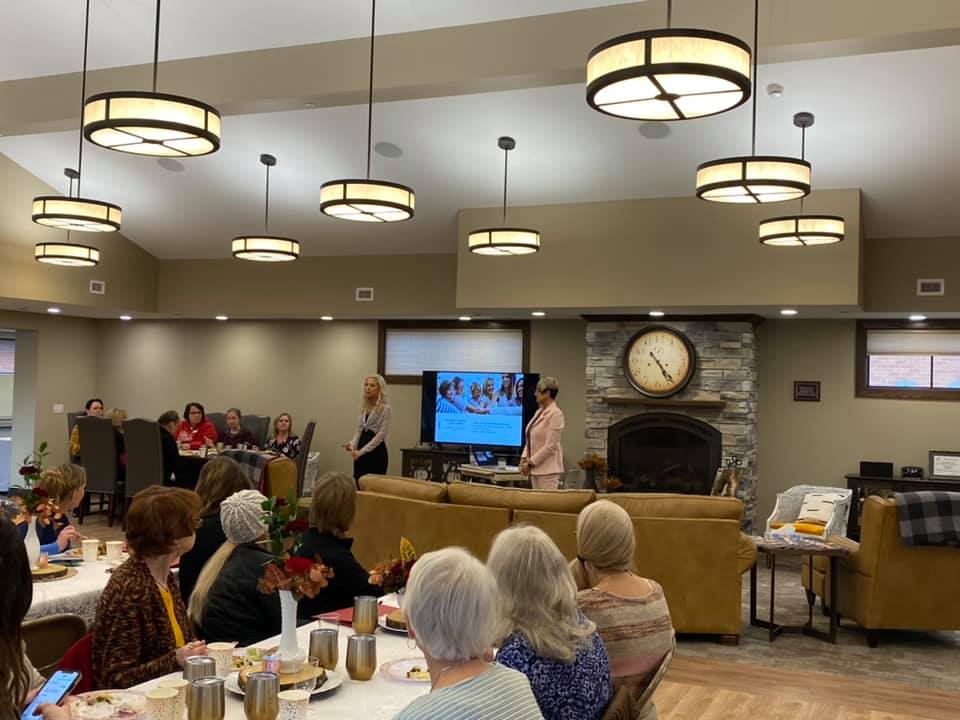Women’s Health Expo Held

Mountrail County Medical Center and the Mountrail County Health Foundation held their third annual Healthy Women’s Expo at Rosen Place on 8th in Stanley on Monday, March 9th. The even had focused on healthy heart the past two years, but focused on “Healthy Mind for a Healthy You” this year. There were several booths set up to coincide with the theme of achieving health from the inside out, a variety of salads catered by Marilyn Gaebe and desserts from Cookies for You and Little Heifer Bakery. Booths included information from the Ina Mae Ruse Aquatic Center, nursing staff performing blood pressure and A1C testing, information on mammograms, healthy eating, BMI testing, and mental health checks.
As part of the Community Health Implementation Plan, a formal Response to the Needs Assessment, Mountrail County Medical Center pledged to place a high priority on mental health, and to assist community members get the help they need. With statistics showing the number of Americans that die by suicide daily and the suicide rate in ND, the focus changed for this year’s event to mental health and suicide prevention.
Stephanie Everett, MCMC CEO and Foundation Director stated, “We can no longer allow the mental health struggles of our community to go unchecked. We know that with mental health, each day, each moment counts, and Medical Center Staff need to get proactive and build resources to be a part of the solution.” At MCMC, the ultimate goal is to transform the community by encouraging confident communication about mental health so residents know how, where, and when to ask for help. They want to reach people before they enter a state of crisis mentally, and to encourage growth of coping skills as well as decrease stigma.
This year’s speakers started with Alison Traynor. A licensed social worker, she has spent the past five years working to mobilize statewide suicide prevention efforts as the Director of Suicide Prevention and founding member of ND Suicide Prevention Coalition. She started out with their “Swear Jar”. Many are familiar with the premise of paying a fine to the jar. This jar is a symbol to change the stigma one word at a time. In their case, it is the word “committed”. The goal is to quit using the word when it comes to suicide, much in the way efforts were underway to quit using the word “retarded”. She says that we need to think that the word committed is used in cases like sin or crime, and that we need to change the culture with suicide, focusing instead on the person that is suffering.
She also talked about the need to work together to prevent suicide, invest in suicide together and work together to solve the complex problems. She compared talking about the junk drawer. We tend to shove suicide into the emotional junk drawer. We need to open the drawer and explore and talk about the feelings and emotions that go along with suicide.
In North Dakota, the suicide rate is among the highest in the nation. It cuts across all age groups, with the highest increase in those aged 25-34. Relationship loss is the most common cause of suicide, followed by a crisis event. When people are distressed, it can exceed their ability to cope. They experience a perceived sense of isolation and their sense of being a burden increases.
To help combat suicide, she has worked to found Zero Suicide, a healthcare based system. The belief is that with help, there is hope as they build a coalition. It shifts from a person to a system approach. Statistics show that 45% of suicides will have visited a primary care provider within a month. 30% will have seen a mental health professional, 40% will have had an ER visit in the year before their death.
Zero Suicide involves leadership, system wide, to create a culture change, provide training, help identify those at risk, and engage those in treatment and transitioning of care. It also looks at policies and procedures to get the help to those that need it.
They find that statistics show that by implementing a system wide effort, fewer patients will die, there will be decreasing costs and improved morale.
Traynor says that it is important to watch out for the warning signs, including those changes in behavior, speech or mood that have you worried. Be willing to talk about those feelings, including thoughts of killing themselves, feeling hopeless, being a burden, feeling trapped or in unbearable pain. Watch for uncharacteristic behavior changes, especially if they are related to a painful event, loss, or change. They could include increased use of alcohol or drugs, looking for ways to end their life, withdrawing from activities, isolating from family or friends, sleeping too much or too little, visiting or calling people to say goodbye, giving away valued possessions, aggression or fatigue.
Watch for mood changes like depression, anxiety, loss of interest, irritability, humiliation, agitation, or even a sudden relief. If you are worried and think there is a suicide risk, act. Everything else can wait. Traynor discussed ways to ask or talk to someone you are concerned about. They include finding someone comfortable to ask those questions if it is not you. Normalize the conversation by saying something validating and then ask the question. Express understanding that they might be struggling after a certain event. She said to be persistent, but warm and present. Allow them to talk freely without judgement, rather listen and be present. Give them plenty of time to talk, and then make sure you can point them toward resources that can help.
She says that it is a five step plan: ask, keep them safe, be there, help them connect, and then follow up.
Those struggling are helped by connections, relationships, helping with coping and life skills, family, faith, and community. With a person at risk they also discuss safety planning. That includes walking the person at risk through the steps of coping, recognize what has set them off, validate the ways they have gotten through hard times before, and provide strategies to help. It can include people they can reach out to for help, following up with clinicians and making sure the return place is safe. Suicide is complex. It needs a community and system approach to find the answers.
The second speaker of the night was Kora Dockter, a nurse and ND Suicide Prevention Coalition Chair. She is leading a statewide call for healthcare system-wide improvement.
She brings her own story of losing her adult son Steven to suicide. She remembers the day in February of 2014. A sunny, cold day, she was driving. When her vehicle veered off the road and hit a curb, she says an energy went through her that scared her. She found out later that moment was when her son died by suicide.
She says that her son was married, a great husband, dad, and medical provider. He had a strong Christian Faith. In September of 2013, Kora received a call from his wife, telling her Steven was struggling and had attempted to take his own life.
Kora says she was scared, paralyzed, and not sure how to help him. He didn’t want people to know he was suffering, but looking back there were signs and symptoms. Following his attempt, Steven was hospitalized. After three days, he called her and said he was being discharged. Based on how he had just been the day before, she was surprised to say the least. She went to pick him up, expecting to talk about a discharge plan, but instead he walked out with his phone and a piece of paper. She says she knew that was not right, but did not realize how broken the mental health system was. She says that upon his discharge she was told “the place did him more harm than good”. She realized that over time, they were watching him die. He had lost weight. He was not sleeping, and he was in a great deal of pain. This is a silent and lonely disease. Most people do not want to talk about mental health, unlike other health issues. Without support, that won’t change.
A couple of years after his death, Dockter asked for her son’s medical record. She said the red flags were everywhere once she started reading through them. It talked about strong family support, although at the time, no one told them how to help him. It mentioned team meetings and family conferences that did not happen and lacked a safety plan. She says the biggest mistake was trusting someone else to care for her son. The system needs to change.
With Zero Suicide, they are working on these changes. They are working with insurance companies to address reimbursement. They are talking about the facts that if things are not working right with the brain, the body is also affected. Dockter also talked about her faith, saying that after the flood of 2011, she sought God again. Little did she know that as she was going through those difficult times, that god was actually preparing her for the time she would bury her child. She points to that faith as well as she works to change the system.
She says that we are all being pushed to change someone’s life and make a difference. You are more likely to come across someone that is depressed that someone that needs CPR. Show them your light, life, and passion. Help them realize that all life is worth living. Suicide is a disease that does not discriminate by your race, age, or what you make. All are at risk. It is important to create an environment where it is okay to talk about it. Don’t place judgement and don’t wait. Tell someone who can make a difference to put the puzzle pieces in place before it is too late.
You can be part of the change. You can find them on Facebook: ND Suicide Prevention Coalition. Dockter left the group with the message, “It takes a village to raise a child, and a bigger village to save a child. Create a village around those that are hurting.”
Those attending were given an insulated cup to take home. In the cup was a card with the semicolon and a cross. The message on the card read: “We use the semicolon in writing when we join together two closely related sentences. The first part of the sentence could be a complete thought on it’s own, however, the writer decided to keep the sentence going. In the context of mental health, the sentence is your life. The semicolon represents the decision to continue living, and is a reminder that you have complete power over yourself and your life. You are the author of your story. You can choose to keep up the fight, even if there are days were you feel like giving up. It is a symbol of strength and hope.

